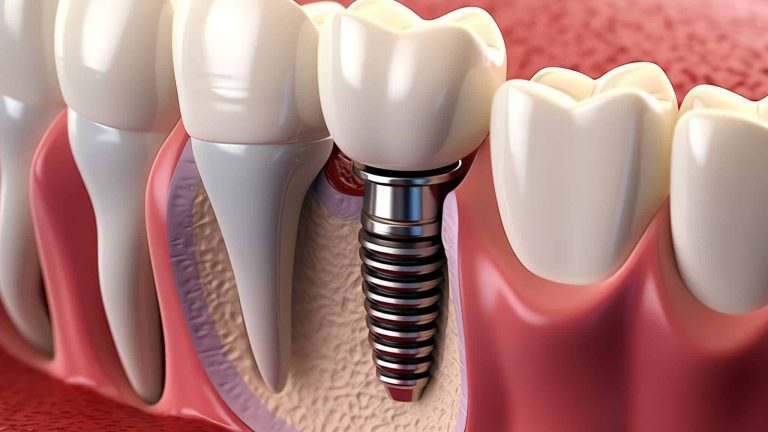Severe tooth pain is one of the most uncomfortable experiences anyone can go through. In many cases, this pain is not caused by a simple cavity but by a deep infection in the tooth’s root. Fortunately, a root canal treatment, also known as endodontic therapy, is a procedure that can save the affected tooth, eliminating the pain and avoiding the need for extraction.
In this article, we will explore what a root canal is, when it is necessary, and how this procedure can save your tooth, preserving its function and aesthetics.
What is a Root Canal?
A root canal is a dental treatment that involves removing the damaged or infected tissue inside the tooth, known as the dental pulp. The pulp is a soft tissue that contains nerves, blood vessels, and connective tissue, and it is located inside the tooth, extending from the crown to the roots.
When the pulp becomes inflamed or infected due to deep cavities, trauma, or fractures, the tooth can become very painful. The purpose of a root canal is to remove this damaged pulp, clean the inside of the tooth, and seal it to prevent future infections. By performing this procedure, the dentist can save the tooth, avoiding extraction and maintaining its function in the mouth.
When is a Root Canal Necessary?
There are several situations in which a root canal may be necessary. Below are the most common signs and symptoms indicating that you may need this procedure:
1. Persistent Tooth Pain
Prolonged or intense tooth pain is one of the clearest signs that something is wrong inside the tooth. If you experience pain that does not go away with painkillers or increases when chewing or applying pressure on the tooth, it is possible that the pulp is inflamed or infected.
2. Prolonged Sensitivity to Heat or Cold
It is normal to feel some sensitivity in your teeth when consuming hot or cold foods or drinks. However, if this sensitivity lasts for several minutes or even hours, it could be a sign that the pulp is damaged and requires treatment.
3. Swelling or Gum Infection
In some cases, an infection inside the tooth can cause swelling in the nearby gums. A small bump or abscess may also appear on the gum, indicating that the body is trying to fight off an infection.
4. Tooth Discoloration
A tooth that has suffered trauma or prolonged infection may become darker than the surrounding teeth. This color change occurs because the tooth pulp is damaged and can be a sign that a root canal is necessary to save the tooth.
5. Dental Fractures or Trauma
Strong blows or trauma that damage a tooth can affect the pulp even if there are no cavities. A root canal may be necessary if the tooth is fractured or if trauma causes damage to the roots.
How is the Root Canal Procedure Performed?
The root canal treatment follows a meticulous process that is performed in several stages. Below, we explain the main steps of a root canal in detail:
1. Evaluation and Diagnosis
Before starting the treatment, the dentist will evaluate the tooth to confirm if a root canal is the best option. This generally includes an X-ray to check the condition of the roots and determine if the pulp is inflamed or infected. In some cases, the dentist may perform additional sensitivity tests to assess the health of the pulp.
2. Local Anesthesia
To ensure that the patient does not feel pain during the procedure, the dentist will apply local anesthesia to the affected tooth area. Even though the tissue inside the tooth is dead or damaged, anesthesia is used to ensure a comfortable experience, especially if there is sensitivity in the gums or surrounding tissues.
3. Tooth Opening and Canal Cleaning
Once the area is numbed, the dentist will make a small opening at the top of the tooth to access the pulp chamber and root canals. Using special instruments, they will carefully clean the damaged pulp and remove any bacteria or dead tissue from the canals. This step is crucial to eliminate the infection and prevent future complications.
4. Disinfection and Tooth Preparation
After cleaning the canals, the dentist will disinfect the area to ensure that no bacteria remain. In some cases, the dentist may apply medication inside the tooth to combat any persistent infection.
5. Tooth Sealing
Once the tooth is completely clean and dry, the root canals are filled with a biocompatible material called gutta-percha. This material is used to seal the inside of the tooth and prevent bacteria from re-entering in the future. The tooth is temporarily covered with a restoration to protect it until the permanent crown can be placed.
6. Placement of the Dental Crown
In most cases, a tooth that has undergone root canal treatment will need a dental crown to restore its shape, function, and appearance. The crown also reinforces the tooth, protecting it from future fractures or damage. This final restoration can be done in a second appointment after the tooth has fully healed.
Benefits of a Root Canal: Saving Your Tooth
The main advantage of a root canal is that it allows you to save a tooth that would otherwise need to be extracted. Keeping your natural teeth has multiple benefits, both aesthetic and functional. Below, we highlight some of the key benefits of a root canal:
1. Preservation of the Tooth’s Natural Function
A tooth that has been treated with a root canal can continue to function like a natural tooth. This means that you will be able to chew and speak normally without the limitations that you might have with a missing tooth.
2. Preservation of Dental Aesthetics
By preserving your natural tooth, you also maintain your smile intact. An extraction can leave a visible gap in your teeth, which could affect your confidence and appearance. With a root canal, you can avoid the need for replacements such as dentures or implants.
3. Prevention of Secondary Dental Problems
When a tooth is extracted, the surrounding teeth can shift, affecting bite alignment and causing chewing problems. By preserving the tooth with a root canal, you avoid these types of complications.
4. Quick and Efficient Treatment
Unlike extraction and implant procedures, which may require multiple appointments and long recovery periods, a root canal can typically be completed in one or two visits, and recovery is quick.
What Happens if a Root Canal is Not Performed?
If a tooth that needs a root canal is not treated in time, the infection can spread beyond the tooth to the surrounding tissues. This can cause the formation of an abscess, a buildup of pus that can lead to severe pain, swelling in the face or jaw, and, in extreme cases, the spread of infection to other parts of the body.
Additionally, if the inflamed or infected pulp is not removed, the tooth will eventually die, and the only option will be extraction. This not only affects the appearance of your smile but can also require more complex and costly treatments in the future, such as dental implants or dentures.
Post-Root Canal Care
After a root canal, it is normal to experience some sensitivity in the tooth for a few days. This discomfort can usually be managed with over-the-counter pain relievers and should gradually subside. Here are some tips to care for your tooth after the treatment:
- Avoid chewing hard foods until the permanent crown is placed.
- Maintain good oral hygiene by brushing your teeth twice a day and flossing daily.
- Attend your scheduled dental check-ups to ensure proper recovery and to check for any complications.
Conclusion: Root Canal, A Solution to Save Your Tooth
A root canal is a highly effective procedure that can save a damaged or infected tooth, allowing you to preserve your smile and avoid the need for extraction. If you experience persistent tooth pain, prolonged sensitivity, or gum swelling, it is important to consult your dentist as soon as possible to receive the appropriate treatment.
At Clínicas La Guardia, we have endodontic specialists who will provide you with the care you need to save your teeth and maintain your oral health. Schedule your appointment today and discover how we can help you preserve your smile and relieve any dental discomfort.



